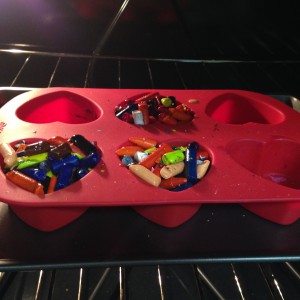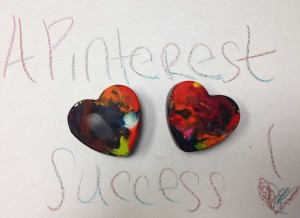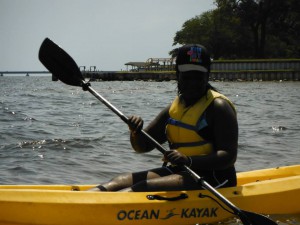by Stefanie Prevatt | Feb 13, 2015
I have a love-hate relationship with Pinterest. I am, admittedly, a perfectionist. And Pinterest sets me up for failure. Perhaps it’s because I am the least crafty person you will ever meet, but nothing ever turns out the way it looks in the photos. Yet, I keep searching and trying new things.
Today’s Pinterest find was a neat little project I found here. I was immediately drawn in by the cute little hearts and the idea that no sweets are involved! Upon exploring this project further, I came to believe this had success written all over it: find crayons, chop up crayons, melt. Easy peasy. Turns out, things were a little more complicated than that, but I would still suggest this as a doable project for 4-H’ers of any age (with proper adult supervision, of course).
Crayon Hearts
1. Collect used crayons. Ask members to bring them to your meeting. You want a good mixture or bright and dark colors.
2. Peel paper off crayons. This was by far the most tedious task. If you will be doing this activity with younger 4-H’ers, I would bring the crayons already peeled.
3. Cut crayons into small pieces. Upon completing this, I realized I should have cut mine a little smaller to help with their melting.

cut crayons
4. Put crayons in silicone baking tray. 230 degrees for 15-20 mins.

baking crayons
5. Let heart crayons cool and remove (more like peal) from tray.
Now what?
There is so much more to this activity than breaking crayons and melting them into hearts.
- Teamwork is required to prepare all the materials. Don’t forget, crayons won’t peal themselves!
- Planning and organizing are required if youth want to have hearts turn out a certain color. Check out these crayons.
- Decision making is necessary to figure out what will be done with the crayon hearts.
- Should the hearts be donated to a local children’s hospital or Ronald McDonald House?
- Older youth can figure out the per item cost of each heart and compare it to the cost of store-bought gifts.
Whether you need something related to your specific project area or you are seeking an idea for a fun, themed activity, Pinterest will certainly not disappoint. Don’t forget, even if your activity turns into a Pinterest fail, celebrate the teachable moments and successes along the way!

A Pinterest success!
References:
Crayon hearts: https://www.pinterest.com/pin/115334440431430268/
Nifty crayon hearts: https://www.pinterest.com/pin/409898003556943584/
by Whitney Cherry | Feb 6, 2015

Don’t let the weather ruin your club’s recreational time. Play inside!
It’s that time of year in North Florida when we’re not sure what we’ll wake up to each morning. We may be in short sleeves, sweatshirts, or hip waders and that can make planning a club meeting tough. During this time of year, between the cold and the rain, it’s seldom that our youth are allowed to go outside for PE. And in lower grades, where a gym may not be available, they are often not getting any significant amount of physical activity during the school day. This is neither good for their mental or physical health, so how can we combat the winter-blues in our club meetings? Here are a few suggestions:
Indoor relay and tag games: If space permits, move the furniture out of the way, and let the kids play freeze tag or have a relay race. Relays are often easy to relate to the educational topic of your meeting. Examples include:
- Set the table relay: where youth draw a piece of a table setting out of a paper bag, run to a table across the room, and put it in its proper place on the table. (the floor can be used in place of a table if need be.) The first team to correctly set the table wins.
- Salsa relay: youth put plastic tomatoes or peppers or onions or garlic between their knees and “run/waddle” around a cone, chair, or tape mark, at the other end of the room back to their team where they pass on their piece of food to the next team mate. The first team to have each player complete the task wins.
- Traditional balloon and ring races are always good too.
Exercise bingo: Contact your local extension office for a copy of exercise bingo. In this high intensity game, each youth or team of youth, is given a bingo card and a stack of exercise cards which face down on the floor. A teammate flips an exercise card, and each team member completes the task on the card (arm circles, pushups, jumping jacks, etc.) If their bingo card includes this exercise, the team captain marks that spot off of their card. Teammates take turn flipping exercise cards until they have Bingo. The first team to get Bingo wins.
Simon Says, Duck-Duck-Goose, London Bridge: These games require only a little space, and are still fun for younger youth, especially Cloverbuds (4-7 yrs). Simon says can often relate to your educational program as well. Ex – “Simon says comb your steer.” “Simon says, stir the batter.” “Simon says bait your hook.”
Legos, board games, etc.: It’s not very active, we know, but sometimes space just doesn’t allow for much physical activity, but it’s still important for youth to have time to interact with each other and relax. Be sure not to pick board games that may take hours to complete. Things like Charades, Guestures, Win, Lose or Draw, etc. are great options.
Now it’s your turn. Get creative, and in the comments section below, share with us the ideas you have for indoor recreation!
by pmdavis | Jan 5, 2015

While youth are home over winter break, encourage them to do something fun that will attract wildlife. Nothing is more fun than watching birds or squirrels play in your yard. One way to make this happen is to provide a supplemental food source for them. You can create a special “Tree for Wildlife” in your yard. In fact, a great family activity is making some very inexpensive simple feeders. The most wonderful part is these feeders, they not only look attractive, but help wildlife survive through the winter.
You can create feeders out of bread, bird seed and a binding agent like eggs, lard or peanut butter. Cut stale bread into shapes with cookie cutters. Make a small hole in the top to put twine or string through. If using egg, brush the bread with egg wash and dip in seeds. Then let it dry for a day or so. Attach string and hang in the trees. If using lard or peanut butter, toast the bread to dry it out then spread like you would on a sandwich and roll in bird seed.
Another type of feeder that is popular especially if you have lots of pine trees are pine cone bird feeders. Attach string to a pine cone. Mix peanut butter and oats together then apply to pine cone. After the cone is covered with the mixture roll in bird seed. Lard can be used in place of peanut butter. Hang from tree.
One last type of feeder is using apple and orange slices. Cut thin slices of apples and oranges, attach string and hang each slice separately all around the tree.
Additional feeders could be strings of grapes, raisins, cranberries, raw peanuts, salt free crackers or popcorn. If you are using popcorn be sure it does not have butter and salt. Just use a needle and thread to make the strings. All edible decorations should be hung with biodegradable materials such as cotton string, twine, or thread.
For more information to help you invite wildlife into your yard check out Junior Master Gardener: Wildlife Gardener or Cornell Feeder Watch. Inviting wildlife into your yard provides a fun way for kids to develop a culture to care about nature, while teaching them about their environment. It also makes a great family traditional activity to do not only during the holiday season but throughout the year. 4-H is one of the nation’s most diverse organizations and includes people from all economic, racial, social, political, and geographic categories. There are no barriers to participation by any young person. Participants are given the opportunity to engage in activities that hold their personal interest, while being guided by adult volunteers. The local 4-H Agent is a youth development professional who provides direction and program leadership as part of the nationwide Cooperative Extension System. For more information, contact UF/IFAS Extension at http://florida4h.org/
.
by Heather Kent | Jul 30, 2014

Couch Camping with Cloverbuds
Sometimes, kids are just too young to fully enjoy the overnight camping experience. In 4-H, children need to be a least 8 years old (by September 1st) to attend overnight camps. Couch camping is a great way for Cloverbuds (4-H members between the ages of 5 and 7) to explore the world of camping without the mosquitos, rain, or anxiety of being away from home. Couch camping is also a great alternative when your work schedule or the weather do not allow for a “real” camping trip. Below are three simple tips for getting the most out of your next couch campout!
- Atmosphere– Push the furniture against the wall and set up a tent in your living room. Bring out the sleeping bags, pillows, and camp chairs. String white lights over the tent to simulate stars and let the kids decorate empty paper toweling tubes to simulate logs for the campfire. Red lights or tissue paper make great flames. Download sounds of frogs, crickets, and other forest sounds to play in the background. Then all that’s left is to dim the lights and turn on your battery operated lanterns.
- Food– Camp food is a must! Serve hotdogs or your favorite campfire meal and don’t forget the popcorn and s’mores. To make s’mores indoors, simply place your marshmallows, graham crackers, and chocolate in the microwave for 10-20 seconds. The marshmallows and chocolate will get gooey- the perfect consistency for s’mores. If you are worried about stains on the carpet, place a tarp or plastic tablecloth under your “campfire” eating area.
- Activities– This age group will really enjoy pretend play. Have toy fishing poles and nets for them to fish with. Use stuffed animals (such as frogs, bears or squirrels) and allow them to “track” the animals. Let them build a campfire with wooden blocks. Make shadow puppets or try flashlight reading. Build a simple birdfeeder out of a pinecone, peanut butter, and birdseed. You can also try a scavenger hunt or campfire BINGO. 4-H campfire songs are also fun, but we do not recommend ghost stories for this age group.
If you enjoy working with 5-8 year olds, consider becoming a 4-H Cloverbud Volunteer. There will be a training for Cloverbud Volunteers and preschool teachers on January 24th in Marianna, FL from 10AM-3PM. Participants will receive teaching kits for working with 5-7 year olds, and CEUs will be available for teachers. For more information, contact Heather Kent at hckent@ufl.edu.
by Melanie Taylor | Jul 9, 2014

4-Hers still enjoy swimming and kayaking in the Choctawhatchee Bay. Photo provided by Jackson County 4-H.
Summer is here, and for most 4-H families, that means camp is on the horizon. If this will be your child’s first summer camp experience, you and your child both may have some camp anxieties. But never fear! Here are some simple steps you can take to prepare your camper (and yourself) for camp:
Preparing Campers:
• Plan several sleep overs before the week of camp arrives. Resist the urge to pack their bags for them or to check on them while there. If they have a cell phone, have them leave it at home. This is a good way to practice not having direct or constant contact.
• Encourage them to write a letter to someone (maybe you) while at camp. You will be so excited when you receive a letter from camp! Be sure to include envelopes, addresses, stamps, paper, and a pen in their luggage.
• Gear up physically. If you have purchased new tennis shoes, break them in with a few long walks, so the blisters don’t have to happen at camp.
• Especially for teenagers, have them take a mini-vacation from their electronic devices. A couple of hours or a weekend.
• Have them write a statement for their social media pages. “Peace out Facebook, I will be at camp for the next week. Check in with you when I get back.” Or something similar.
• Have them write down their goals for camp. So they can mentally prepare themselves for what they hope to do and see.
• Make a homesick plan:
1. Homesickness isn’t entirely bad. It’s great to love your home. It’s sometimes part of the process, and it’s a confidence booster when a camper gets through it.
2. Make a happy place plan and write it down. This is an amazing opportunity to learn a life skill. Today’s youth go to technology to escape, and studies show this increases their stress. Some ideas might be: taking 10 deep breaths, traveling to a happy place in your mind, packing a certain stuffed animal, or tossing a football. They are capable of this independence.
3. Your plan should NOT be, “Give it a couple of days and if you don’t like it, we will come get you.” This will set them up to give it a couple of days and knock the confidence right out of them.
4. Let your camper know what to expect with correspondence. You don’t need to write every day, but let them know what to expect.
Parents:
• You are giving your child an incredible gift. I cannot promise you that they will not lose some socks, that they will love every meal or activity, or that they will adore every counselor. But you are preparing them for college and beyond; you are giving them the freedom to gain confidence, independence, and leadership skills; and you are instilling in them that they can do it.
• What do YOU want to do during their time at camp? Plan a vacation for a later time, time to organize, time to have one-on-one time with your other children, or some “date nights” with your spouse or friends.
• If you have apprehensions, work to resolve them. If you are worried that your camper is not going to know anyone, set up a pre-camp get-together. If you are worried about your camper’s medical needs, become friendly with the camp staff. If you are anxious about their food allergies, talk to the camp’s director. Make a camper-sick plan for yourself. Make sure there is only excitement and optimism coming from you, and share your anxiety with another adult.
• Pack self-addressed envelopes in their luggage.
• Whether they are flying or driving, refrain from crying your eyes out until they cannot see you. Take a deep breath, trust, and remind yourself that you are giving them an awesome gift.
And, what is this gift everyone is talking about? At camp, they will be part of a community all their own. They will become emotionally attached to handmade rope bracelets on their wrist, and have a song for any occasion on cue, and maybe even forget they need to shower, and think sunscreen is just a normal daily moisturizing technique. They will learn to do things on their own, and they’ll learn to rely on others. They will learn how to survive on their own for a week or two, and they’ll learn how to help each other through it.
They may even grow up on summers away from TV, and forget Facebook exists. They will relish in the joy of sleeping in cabins, swatting mosquitoes at campfire, and swimming every day. They will savor the feeling of pushing water behind them with a paddle and the whoosh of air behind the tail of an arrow as they fire. They’ll forget about appearances, relish tan lines, and recognize the beauty of a smile over anything else.
So send your kids to camp. Send them so they’ll learn to set tables and make beds and wake early. Send them so they’ll know how to be a leader, paddle a kayak, weave a bracelet, and sing as loud as they can. Send your kids to camp so they’ll learn to love themselves and learn to love others. Send your kids to camp because they’ll realize who they are, or who they want to be. And, prepare yourselves for a year of camp stories, and for a flurry of songs. Prepare to learn names of kids you’ve never met. And for your kids to have a need for sunshine, a need for campfires, and companionship. They will be forever grateful for your awesome gift of summer camp.
Source:
American Camping Association, Inc. (http://www.acacamps.org)
by jgl1 | Nov 8, 2013
John G. Lilly
jgl@ufl.edu
Jefferson County Extension Director/4-H Agent
Young people in 4-H are committed to improving their communities. Dr. Richard Lerner, and the team at the Institute for Applied Research in Youth Development at Tufts University highlights a notable trend. 4-H youth are three times more likely to actively contribute to their communities when compared with youth who do not participate in 4-H. (more…)







